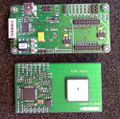Difference between revisions of "Yapa"
Jump to navigation
Jump to search
| Line 1: | Line 1: | ||
"'''Y'''et '''A'''nother '''P'''aparazzi '''A'''utopilot" | "'''Y'''et '''A'''nother '''P'''aparazzi '''A'''utopilot '''v1''' and '''v2'''."<br> | ||
[[Yapa|Yapa]] is very similar to the [[Twog_v1|Twog_v1]] but has standard 100mil headers for direct standard servo connections, and has an option to put the xbee on the autopilot-board itself. | |||
''When would you use a TWOG'': | ''When would you use a TWOG'': | ||
| Line 13: | Line 14: | ||
*or you want standard servo connectors or have high power servo's | *or you want standard servo connectors or have high power servo's | ||
*a few extra grams don't matter | *a few extra grams don't matter | ||
*want to connect any serial device (from a TLL/RS232 GPS to the latest RS422 XSens Mti-G) | *want to connect any serial device (from a TLL/RS232 GPS to the latest [RS422 v1 only] XSens Mti-G) | ||
*you want to connect an rs232/485/422 modem or an XBee directly | *you want to connect an rs232[/485/422 v1 only] modem or an XBee/LT2510 directly | ||
== Hardware Revision History == | == Hardware Revision History == | ||
| Line 34: | Line 28: | ||
|} | |} | ||
== Features == | |||
== Yapa v2 == | |||
<gallery> | |||
Image:yapa_v2_xsens.jpg|Sample Use | |||
Image:yapa_tiny_compare.jpg|Comparison | |||
Image:yapa2.jpg|A few | |||
</gallery> | |||
<br> | |||
=== Features === | |||
* upgrade on v1 with | |||
* 10 servo's instead of 8 (caution: standard pprz code only drives 8) | |||
* extra ADC | |||
* GPS-reset | |||
* Cam-Switch | |||
* Remotely locatable USB (without need to unsolder the usb on the board) | |||
* Remotely locatable XBee (or other) modem | |||
* Resistor to select RS232 or 3.3V GPS/IMU/Modem | |||
* 3 LED instead of 1 | |||
* More space around the mounting holes | |||
== Yapa v1 == | |||
<gallery> | |||
Image:Yapa_v1-00_rendering.jpg|Rendering | |||
Image:Yapa_v1-00_top.jpg|Top side | |||
Image:Yapa_v1-00_bottom.jpg|Bottom side | |||
</gallery> | |||
<br> | |||
=== Features === | |||
* Basic Design very similar to [[Twog_v1|Twog_v1]] (uses same autopilot configuration file 'tiny2_1_1.h') | * Basic Design very similar to [[Twog_v1|Twog_v1]] (uses same autopilot configuration file 'tiny2_1_1.h') | ||
| Line 60: | Line 86: | ||
== Architecture == | == Architecture == | ||
[[Image:Yapa_v1-00_schematics.png|900px|Yapa v1.0 Schematic]] | [[Image:Yapa_v1-00_schematics.png|900px|Yapa v1.0 Schematic]] | ||
== Files == | == Files == | ||
[[Media:Yapa_gerber.zip]] | [[Media:Yapa_gerber.zip]] | ||
| Line 68: | Line 96: | ||
[[User:Cdewagter|cdewagter]] | [[User:Cdewagter|cdewagter]] | ||
[[Category:Hardware]] | [[Category:Hardware]] | ||
Revision as of 09:22, 29 March 2011
"Yet Another Paparazzi Autopilot v1 and v2."
Yapa is very similar to the Twog_v1 but has standard 100mil headers for direct standard servo connections, and has an option to put the xbee on the autopilot-board itself.
When would you use a TWOG:
- size and weight matter
- you have a Molex Crimper
When YAPA might be useful:
- you want to use the exact same airframe file as in a TWOG
- but you want mounting holes
- or you want standard servo connectors or have high power servo's
- a few extra grams don't matter
- want to connect any serial device (from a TLL/RS232 GPS to the latest [RS422 v1 only] XSens Mti-G)
- you want to connect an rs232[/485/422 v1 only] modem or an XBee/LT2510 directly
Hardware Revision History
| Version # | Release Date | Release Notes |
|---|---|---|
| v2.00 | 02/2011 | Redesign: replaced the dual very expensive rs422/485/232 multiprotocol driver with a single rs232 and much more IO pins |
| v1.00 | 07/2010 | Initial release of Yapa v1 |
Yapa v2
Features
- upgrade on v1 with
- 10 servo's instead of 8 (caution: standard pprz code only drives 8)
- extra ADC
- GPS-reset
- Cam-Switch
- Remotely locatable USB (without need to unsolder the usb on the board)
- Remotely locatable XBee (or other) modem
- Resistor to select RS232 or 3.3V GPS/IMU/Modem
- 3 LED instead of 1
- More space around the mounting holes
Yapa v1
Features
- Basic Design very similar to Twog_v1 (uses same autopilot configuration file 'tiny2_1_1.h')
- 100mil headers instead of the (nice and lighter) Molex connectors
- Support Holes (e.g. use M3 bobbins: [1])
- 5 x Analog 3.3V inputs with 2 of them low pass filtered
- (Optional) 2x RS232/RS422/RS485/3.3TLL serial ports for connecting virtually any serial device (if using xbee: then 1 port)
- (Optional) Onboard (optional) Xbee Modem
- 8 x PWM outputs on standard 1/10th inch headers
- 1 x R/C receiver PPM frame input
- 1 x SPI bus
- 1 x I2C bus
- 1 x USB (client) with either onboard mini-usb AND/OR remotely located USB Plug
- 2x 3.3v / 1A linear regulator for Processor and for XBee modem separated for safety
- 1 x status LEDs
- 80.0 x 40.0mm
- 23 grams including 2.4GHz Xbee Pro, all 100mil headers, usb connector, 2.5Amp 5V DCDC and serial converter
- 1 power switch with current limiter
- 2 layers PCB design, 0603 components
- (Optional) onboard 5v / 2.25A switching power supply (input voltage range 6.1v → 18v)
- 3 power options using a jumper/bridge to connect the servo power rail to the autopilot 5V power rail:
- In the case of few very low power servo's: you power your servo's from the autopilot power (not recommended: in any case check to make sure all servo's together never ever use more than 1.5 amp even when blocked)
- In the case of a high quality external BEC: you can omit the onboard regulator and power everything from the BEC.
- Otherwise: separated onboard autopilot 5V power and externally supplied servo power





